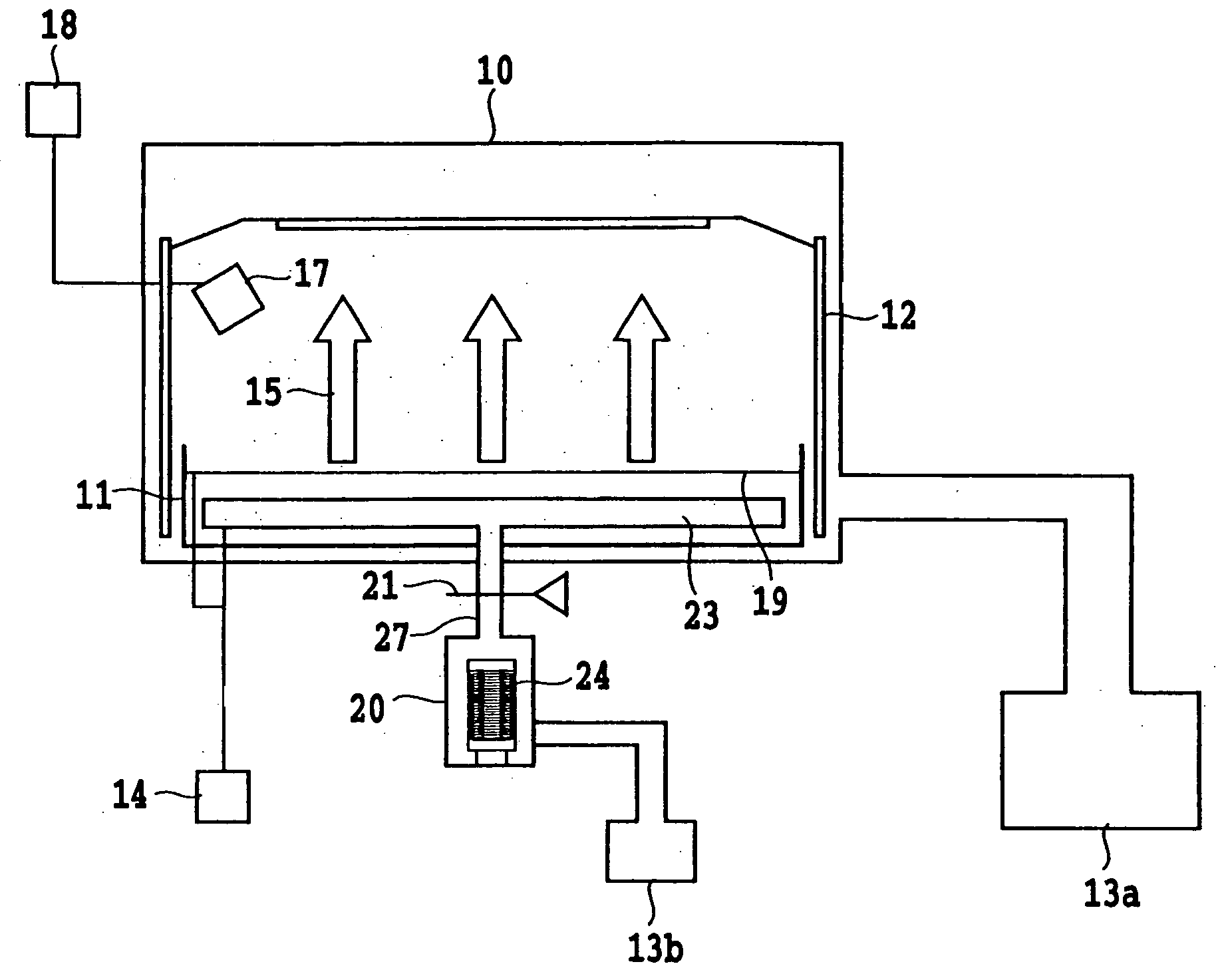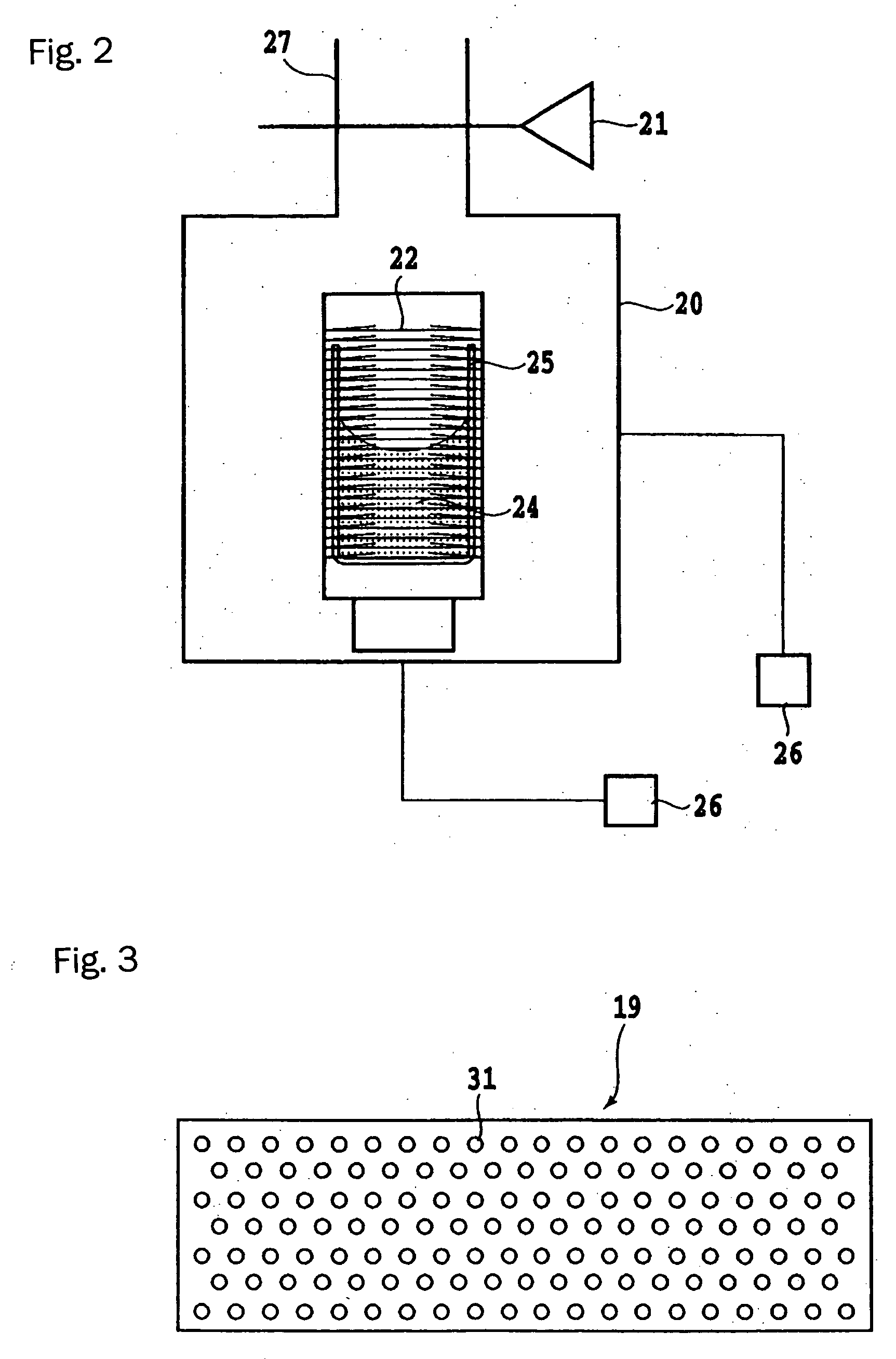Organic thin film manufacturing method and manufacturing apparatus
a technology of manufacturing method and manufacturing method, which is applied in the direction of vacuum evaporation coating, instruments, spectales/goggles, etc., can solve the problems of long time required, complex control of material heating method, and low material utilization efficiency
- Summary
- Abstract
- Description
- Claims
- Application Information
AI Technical Summary
Benefits of technology
Problems solved by technology
Method used
Image
Examples
example 1
[0053] Using the film manufacturing apparatus shown in FIG. 1, a confirmatory test was carried out into the stability of the film formation rate. Glass substrates each having dimensions of 50 mm×50 mm were arranged in 15 rows by 3 columns in a substrate holder having a mounting region of dimensions 770 mm×150 mm inside vacuum chamber 10, which had an internal volume of 0.2 m3. Blocking plate 19 had dimensions of 800 mm×200 mm, and had circular stream-regulating holes of diameter 3 mm distributed uniformly over the whole thereof, with the aperture ratio (total area of stream-regulating holes / total area of blocking plate) being 0.5%. The distance between blocking plate 19 and the substrates was made to be 150 mm. Moreover, a crucible 25 having a bore diameter of 50 mm and a depth of 100 mm was provided in the material introducing part 20, which had an internal volume of 0.05 m3, and 100 g of aluminum tris-(8-quinolinolate) (Alq3) was charged into the crucible 25. Alq3 is a material th...
example 2
[0059] Using the apparatus described in Example 1, film formation was carried out over 30 seconds such that the mean film thickness would be 300 nm, thus forming Alq3 on the glass substrates.
[0060] After that, the film thickness of the organic thin film was measured for all of the glass substrates using a stylus type film thickness gauge. The result was that the film thickness variation index (the ratio of the thickness of the thinnest organic thin film to the thickness of the thickest organic thin film out of the 45 glass substrates) was 0.9 or more. This demonstrates that thin films of uniform thickness with little fluctuation in the film thickness can be formed according to the organic thin film manufacturing method of the present invention.
[0061] Furthermore, using the apparatus of the present invention, an investigation was carried out into the reproducibility of the film thickness upon carrying out film formation many times. Using the apparatus of Example 1, 30 seconds of Al...
example 3
[0065] Using the film manufacturing apparatus of Example 1, trial manufacture of organic EL devices was carried out. Three film manufacturing apparatuses according to Example 1 were linked to a vacuum vessel for conveyance having a load lock, so that substrates could be moved between the film manufacturing apparatuses without releasing the vacuum. Glass substrates (dimensions 50 mm×50 mm) on each of which an ITO film had been formed to a thickness of 100 nm were mounted, arranged in 15 rows by 3 columns, on a substrate holder having a mounting region of dimensions 770 mm×150 mm, and the substrate holder was conveyed into the vacuum vessel for conveyance from the load lock.
[0066] Next, the substrate holder was conveyed into the first film manufacturing apparatus, and an α-NPD film of thickness 40 nm was deposited at a film formation rate of 2 nm / sec, thus forming a hole transport layer on each of the substrates. The substrate holder was then conveyed into the second film manufacturi...
PUM
| Property | Measurement | Unit |
|---|---|---|
| pressure | aaaaa | aaaaa |
| temperature | aaaaa | aaaaa |
| thickness | aaaaa | aaaaa |
Abstract
Description
Claims
Application Information
 Login to View More
Login to View More - R&D
- Intellectual Property
- Life Sciences
- Materials
- Tech Scout
- Unparalleled Data Quality
- Higher Quality Content
- 60% Fewer Hallucinations
Browse by: Latest US Patents, China's latest patents, Technical Efficacy Thesaurus, Application Domain, Technology Topic, Popular Technical Reports.
© 2025 PatSnap. All rights reserved.Legal|Privacy policy|Modern Slavery Act Transparency Statement|Sitemap|About US| Contact US: help@patsnap.com



